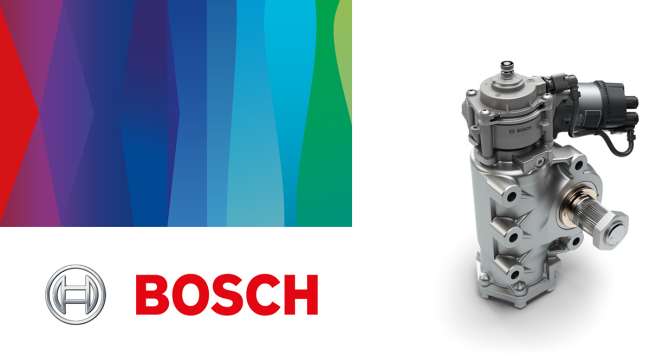Senior Reporter
Bosch Research Calculates Value of Level 2 ADAS

[Stay on top of transportation news: Get TTNews in your inbox.]
Bosch Research announced that recent accident data it studied pointed to significant potential reductions in injuries and deaths, and to the cost savings that could result from equipping Classes 7-8 vehicles traveling U.S. highways with advanced driver assistance systems focused on a truck’s position in a lane, such as lateral actuator systems.
The Bosch accident research, titled “Safety + Enhanced Driver Comfort: Steering in Commercial Vehicle ADAS Systems,” found that lateral actuator systems — such as lane-change assist (LCA) and lane-keeping support (LKS) can reduce the costs of accidents by up to 4 cents per mile, or $3,700 annually per heavy truck.
The study also found lateral actuator systems may reduce costs associated with property damage by up to 35% when the truck is the triggering vehicle.
Reducing crash fatalities in accident-triggering vehicles by up to 19% is just one of the benefits of having ADAS in heavy trucks. Learn more in our latest #research findings https://t.co/TGYbQMo8kh https://t.co/3WSpnA4UDq pic.twitter.com/ihLyvTcPZo — Bosch USA (@boschusa) March 19, 2021
Injuries from large truck crashes were potentially reduced by up to 23% and associated fatalities by up to 19% when the truck is the triggering vehicle.
“These are the upper limits of what could be saved when you look at Classes 7-8 trucks as the accident-triggering vehicle,” said Kevin Chronicle, head of sales and marketing in North America for commercial vehicle and new electric vehicle customers in automotive steering at Bosch.
Bosch steering in North America is in Plymouth, Mich., and is a unit of the Germany-based Bosch Group.
“All we can do is look at publicly available road data,” he said, “and use those figures to analyze them and ask, theoretically, what’s the most cost-avoidance you could have from these accidents, what’s the number of injuries and deaths and property damage that potentially could be avoided as an upper limit. Depending on the efficiency of the system put in place that number could be less, for example.”
One industry expert endorsed the company’s methodology.
“The Bosch analysis uses a solid analytical approach to arrive at their results,” Richard Bishop, automated trucking expert at Bishop Consulting, told Transport Topics.
“ADAS for lane-change assist and lane-keeping support has clearly shown its value in the passenger car space by automatically steering the vehicle to support and aid the driver,” Bishop said.
In December 2019, the Insurance Institute for Highway Safety forecast the number of registered automobiles equipped with lane-departure warning systems would increase to 28.2% in 2023 compared with 8.1% in 2018.
“This is mature technology and has entered the trucking space only recently. Safety-first fleets which have adopted automatic emergency braking will no doubt be interested in taking a look at these steering-focused systems,” Bishop said.
Level 2 technology for trucking was launched in 2020, said Chronicle.
Level 2, as defined by SAE, is an automated system that can assist the driver with multiple parts of the driving task for extended periods. The driver must continue to monitor the driving environment and be actively engaged.
“We are seeing significant growth in this market. Year-over-year 2020 to 2021 has seen strong demand, and even stronger for 2022. It is important that we continue to educate the market in parallel,” Chronicle said.

Even before the pandemic, DHL's Larry S. Onge and Jim Monkmeyer set up strategies and implemented technology in order to respond to disruptions. Now, they know exactly how to get the vaccine from point A to point B — and, better, how to do it at a global scale. Hear a snippet, above, and get the full program by going to RoadSigns.TTNews.com.
Bosch’s accident research reviewed public crash data to identify correlating statistics between vehicle types and the severity of crashes, according to the company. This data was used to calculate a Field of Effect (FoE) for accidents involving large trucks. To calculate FoE, crashes were examined that could have been mitigated or avoided by using lateral actuator systems — more specifically, LCA and LKS.
The KABCO injury scale, developed by the National Safety Council — and used by police to categorize an accident at the scene of the incident — provides a specific process to classify the costs of crashes. Using the KABCO scale and based on a driving distance of 100,000 miles per year, the Federal Highway Administration’s estimate for long-distance heavy trucks, the FoE was translated into dollars.
The research shows that even at an assumed 50% efficiency of the FoE, the savings from a lateral actuator system could total more than $9,000 per truck in five years, Bosch noted in a release.
“It is a new technology and it is not free. In order to save lives you have to show not only the safety features of it but also that it makes sense financially,” Chronicle said. “That helps fleets adopt the technology.”
Meanwhile, the technology in the study is part of a larger backdrop of technologies, he said, such as: active pull compensation, active steering damping, reducing steering effort, and hydraulic failure detection, and added steering assist can support the driver during hydraulic failure or drastic events like tire blowouts.
“The point is to educate the market. People may not realize that it’s not just a safety system but it actually makes drivers’ lives easier,” he said.
He said the study’s results would prove to be the same if done by others as long as others used the same assumptions. “For example, if you said I want to look at all vehicles not just trucks, or not the accident-triggering vehicle but all vehicles it, of course, changes. But it’s all based on public data. If you follow the same assumptions you will get to the same data.”
Want more news? Listen to today's daily briefing below or go here for more info:


